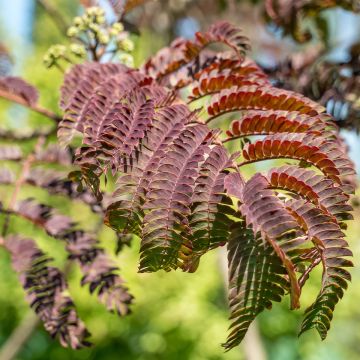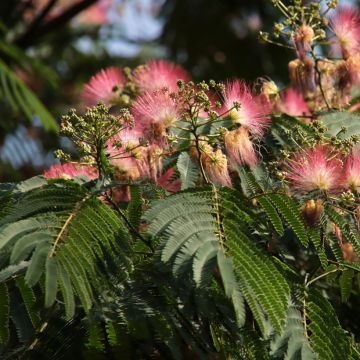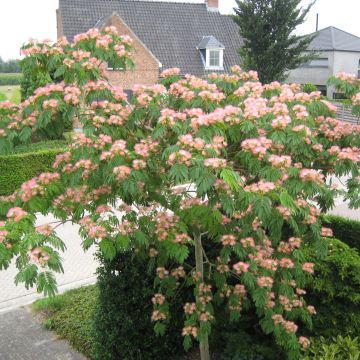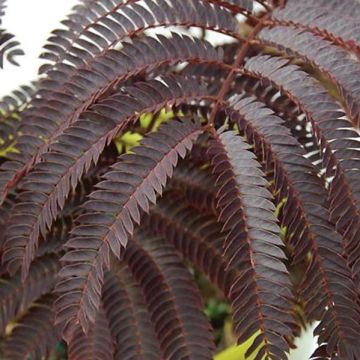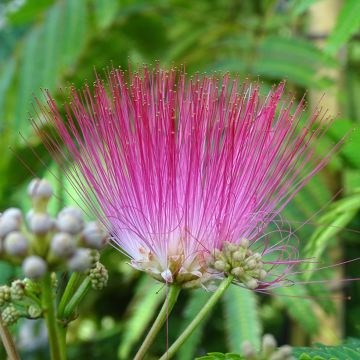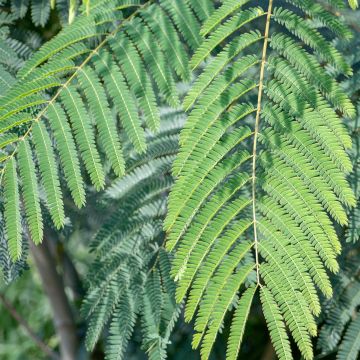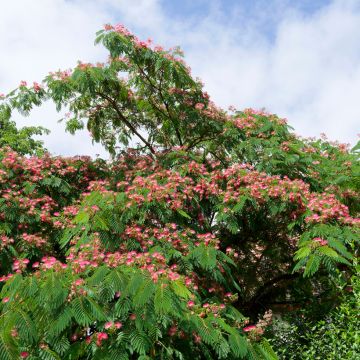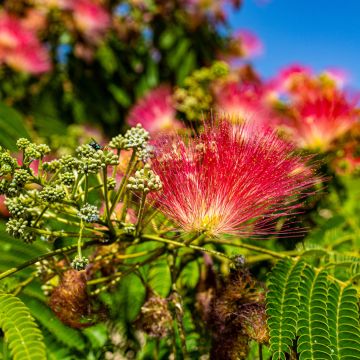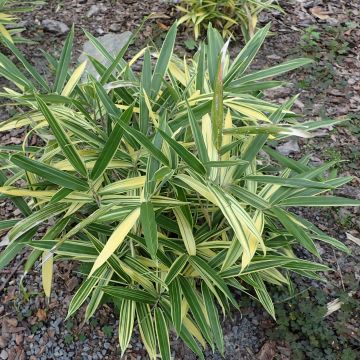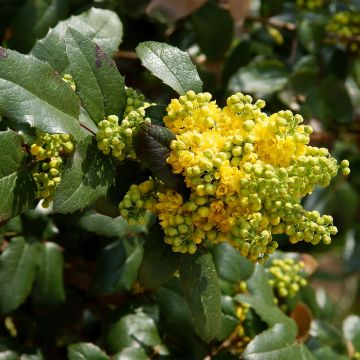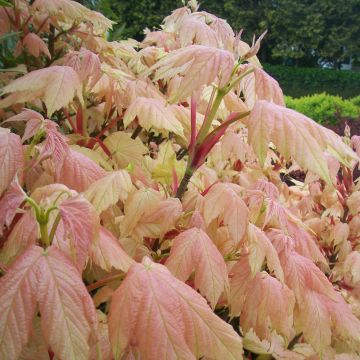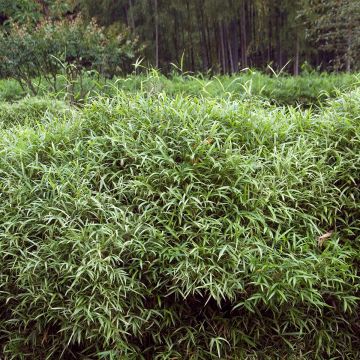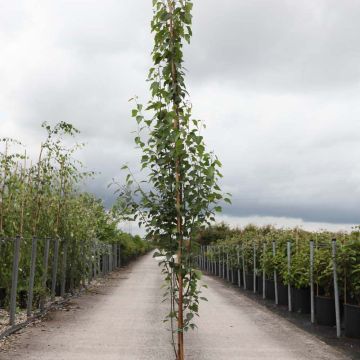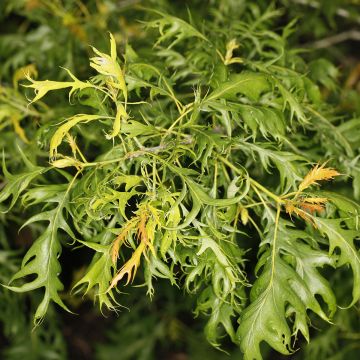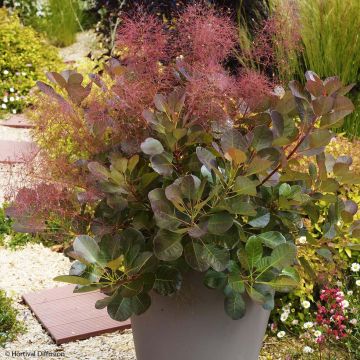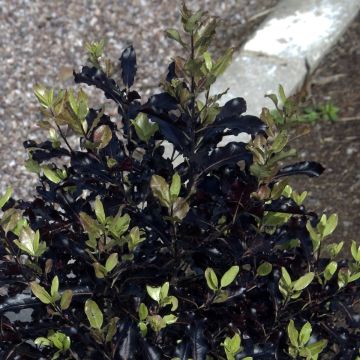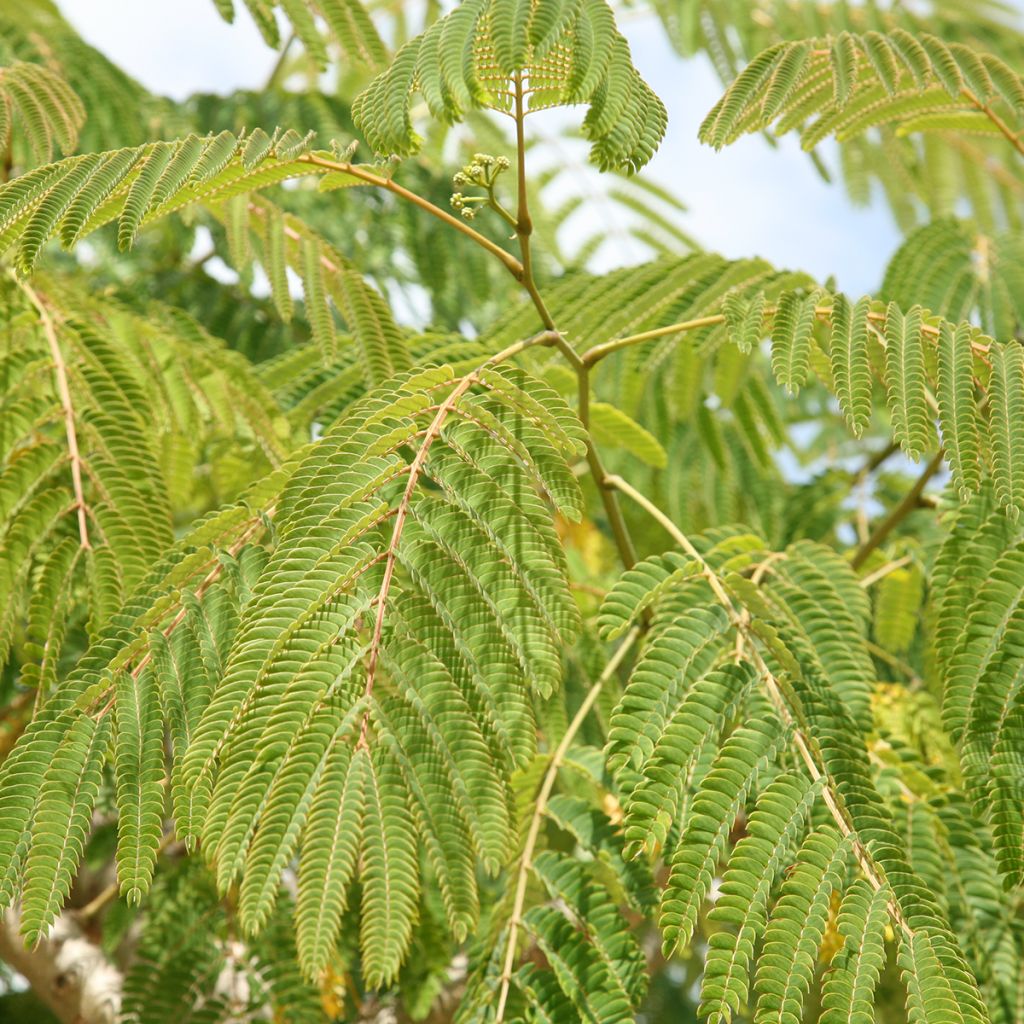

Albizzia julibrissin Ernest Wilson
Albizzia julibrissin Ernest Wilson
Albizzia julibrissin Ernest Wilson
Persian Silk Tree, Pink Silk Tree, Mimosa Tree, Silk Tree, Persian Acacia
Why not try an alternative variety in stock?
View all →This plant carries a 24 months recovery warranty
More information
We guarantee the quality of our plants for a full growing cycle, and will replace at our expense any plant that fails to recover under normal climatic and planting conditions.
From €5.90 for pickup delivery and €6.90 for home delivery
Express home delivery from €8.90.
Delivery to Corse prohibited: UE law prohibits the import of this plant from mainland France to Corse as part of the fight against Xylella fastidiosa. Please accept our sincere apologies.
More information
Does this plant fit my garden?
Set up your Plantfit profile →
Description
The 'Ernest Wilson' Albizia julibrissin is a cultivar discovered in 1918 by an American collector of the same name in the garden of a hotel in Seoul, in central Korea, which is colder than coastal areas. The seeds collected and planted upon his return to cold New England have given rise to a tree that is still thriving a century later. This cultivar is therefore considered the most cold-resistant and exceptionally long-lived. It produces bright white and pink flowers, a particularly vibrant colour against its tender green, finely cut foliage. It should be planted in full sun, in well-drained soil and protected from cold winds.
The Albizia julibrissin is a deciduous small tree of the Fabaceae family, with a distribution range that extends from Iran to eastern China. 'Ernest Wilson' usually reaches a height of 2.5 to 3 m (8 to 10ft) in our climates, but if the growing conditions suit it, it can reach a height of 6 m (20ft) with a similar spread. It develops a spreading canopy with a diameter equal to or slightly greater than its height. This small tree blooms in July-August, in the form of feathery and silky flower heads that have earned it the name of silk tree. They are composed of long stamens in a deep pink colour, white at the base, surpassing the rudimentary corollas grouped in heads. The fragrance of the flowers is most noticeable up close, powdery and sweet. The flowering gives way to a fruit, a flat pod, 8 to 20 cm (3 to 8in) long, initially green and then brown, containing 5 to 15 fairly large oval seeds, which germinate easily. The deciduous leaves, light green, are alternate and very large, measuring from 15 to 40 cm (6 to 16in). They are divided into large leaflets, which are further subdivided into small leaflets. The bark is thin, gray-green and then grey, almost smooth, with whitish lenticels. Finally, and this is a characteristic of plants in the fabaceae family, the roots form nodules capable of fixing atmospheric nitrogen, through specific bacteria present in these organs. The taproot system of this small tree does not tolerate transplantation well. The lifespan of the Albizia is variable, and in our climates it usually reaches around thirty years.
Perfect for small gardens, the 'Ernest Wilson' silk tree charms with its graceful silhouette and light foliage adorned with exotic flowering in summer. It can be planted as a standalone tree, where one wishes to enjoy its light shade, near a terrace for example. It brings a pleasantly exotic touch to the garden. Its hardiness is ensured by planting it in well-drained soil, in full sun, protected from prevailing winds and cold drafts.
Report an error about the product description
Plant habit
Flowering
Foliage
Botanical data
Albizzia
julibrissin
Ernest Wilson
Fabaceae
Persian Silk Tree, Pink Silk Tree, Mimosa Tree, Silk Tree, Persian Acacia
Cultivar or hybrid
Other Albizia
Planting and care
The Albizia 'Ernest Wilson' is preferably planted in early autumn in hotter areas or late winter in areas with cold winters. Resistant to at least -15°C (5°F), choose a warm location, in full sun and sheltered from cold winds. In late winter, between February and March and before the resumption of vegetation, prune dead or diseased wood or any that obstructs to maintain an attractive habit. Severe pruning stimulates vigorous shoots. Beware of psyllid invasions in mild climates.
Planting period
Intended location
Care
This item has not been reviewed yet - be the first to leave a review about it.
Striking foliage shrubs
Haven't found what you were looking for?
Hardiness is the lowest winter temperature a plant can endure without suffering serious damage or even dying. However, hardiness is affected by location (a sheltered area, such as a patio), protection (winter cover) and soil type (hardiness is improved by well-drained soil).

Photo Sharing Terms & Conditions
In order to encourage gardeners to interact and share their experiences, Promesse de fleurs offers various media enabling content to be uploaded onto its Site - in particular via the ‘Photo sharing’ module.
The User agrees to refrain from:
- Posting any content that is illegal, prejudicial, insulting, racist, inciteful to hatred, revisionist, contrary to public decency, that infringes on privacy or on the privacy rights of third parties, in particular the publicity rights of persons and goods, intellectual property rights, or the right to privacy.
- Submitting content on behalf of a third party;
- Impersonate the identity of a third party and/or publish any personal information about a third party;
In general, the User undertakes to refrain from any unethical behaviour.
All Content (in particular text, comments, files, images, photos, videos, creative works, etc.), which may be subject to property or intellectual property rights, image or other private rights, shall remain the property of the User, subject to the limited rights granted by the terms of the licence granted by Promesse de fleurs as stated below. Users are at liberty to publish or not to publish such Content on the Site, notably via the ‘Photo Sharing’ facility, and accept that this Content shall be made public and freely accessible, notably on the Internet.
Users further acknowledge, undertake to have ,and guarantee that they hold all necessary rights and permissions to publish such material on the Site, in particular with regard to the legislation in force pertaining to any privacy, property, intellectual property, image, or contractual rights, or rights of any other nature. By publishing such Content on the Site, Users acknowledge accepting full liability as publishers of the Content within the meaning of the law, and grant Promesse de fleurs, free of charge, an inclusive, worldwide licence for the said Content for the entire duration of its publication, including all reproduction, representation, up/downloading, displaying, performing, transmission, and storage rights.
Users also grant permission for their name to be linked to the Content and accept that this link may not always be made available.
By engaging in posting material, Users consent to their Content becoming automatically accessible on the Internet, in particular on other sites and/or blogs and/or web pages of the Promesse de fleurs site, including in particular social pages and the Promesse de fleurs catalogue.
Users may secure the removal of entrusted content free of charge by issuing a simple request via our contact form.
The flowering period indicated on our website applies to countries and regions located in USDA zone 8 (France, the United Kingdom, Ireland, the Netherlands, etc.)
It will vary according to where you live:
- In zones 9 to 10 (Italy, Spain, Greece, etc.), flowering will occur about 2 to 4 weeks earlier.
- In zones 6 to 7 (Germany, Poland, Slovenia, and lower mountainous regions), flowering will be delayed by 2 to 3 weeks.
- In zone 5 (Central Europe, Scandinavia), blooming will be delayed by 3 to 5 weeks.
In temperate climates, pruning of spring-flowering shrubs (forsythia, spireas, etc.) should be done just after flowering.
Pruning of summer-flowering shrubs (Indian Lilac, Perovskia, etc.) can be done in winter or spring.
In cold regions as well as with frost-sensitive plants, avoid pruning too early when severe frosts may still occur.
The planting period indicated on our website applies to countries and regions located in USDA zone 8 (France, United Kingdom, Ireland, Netherlands).
It will vary according to where you live:
- In Mediterranean zones (Marseille, Madrid, Milan, etc.), autumn and winter are the best planting periods.
- In continental zones (Strasbourg, Munich, Vienna, etc.), delay planting by 2 to 3 weeks in spring and bring it forward by 2 to 4 weeks in autumn.
- In mountainous regions (the Alps, Pyrenees, Carpathians, etc.), it is best to plant in late spring (May-June) or late summer (August-September).
The harvesting period indicated on our website applies to countries and regions in USDA zone 8 (France, England, Ireland, the Netherlands).
In colder areas (Scandinavia, Poland, Austria...) fruit and vegetable harvests are likely to be delayed by 3-4 weeks.
In warmer areas (Italy, Spain, Greece, etc.), harvesting will probably take place earlier, depending on weather conditions.
The sowing periods indicated on our website apply to countries and regions within USDA Zone 8 (France, UK, Ireland, Netherlands).
In colder areas (Scandinavia, Poland, Austria...), delay any outdoor sowing by 3-4 weeks, or sow under glass.
In warmer climes (Italy, Spain, Greece, etc.), bring outdoor sowing forward by a few weeks.

































